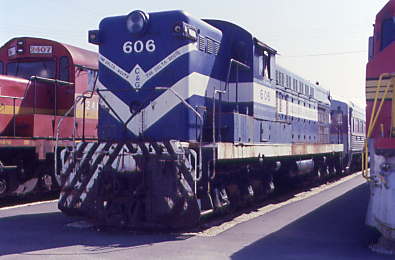
5/3/2003 After a continental breakfast and checking out of the Baymont Inn in Janesville, Wisconsin, I drove US 14 east to Harvard to buy a new watch then drove Illinois 23 south to Marengo, where I turned left onto US 20 and took that to Union Road, which I took through Union, crossed three sets of tracks and pulled up to the locked front gate of my destination. Thirty-five minutes later, the gate was opened.
Illinois Railway MuseumThe Illinois Railway Museum was founded in 1953 by ten men who each contributed $100 to purchase Indiana Railroad 65, an interurban car that had just been retired and was in imminent danger of being scrapped. The museum’s origins, however, actually go back further.
In 1907 the Elgin & Belvidere Electric Railway, controlled by electric railway engineering expert Bion J. Arnold, opened for business. It was an electric interurban line paralleling the Chicago & North Western Railroad between the two cities in its name. One of its claims to fame was that it built the world’s first fully automatic substation in the town of Union. The E&B continued in operation until 1930, when automobile competition and the onset of the Depression drove it into bankruptcy. The tracks were torn up soon thereafter and the interurban cars were scrapped.
When IRM was founded in 1953 it was sited on the grounds of the Chicago Hardware Foundry in suburban North Chicago, along the tracks of the Chicago North Shore & Milwaukee interurban line. It was initially known as the Illinois Electric Railway Museum but the “Electric” was removed in 1962. Following acquisition of car 65 the collection continued to grow, reaching some 40 pieces of equipment by 1964. By that time the museum had outgrown its cramped space at the foundry and it relocated to an empty field east of Union. The reason this site was chosen was because the long-abandoned right-of-way of the E&B could be cheaply acquired simply by paying the back taxes. Initially a mile and a half of right-of-way and a small 26-acre plot where the depot now sits were purchased. The collection of 40 pieces of equipment was transported to Union in 1964.
Over the 60 years since, IRM has expanded steadily. The first electric car operated in 1966 and the first steam engine ran in 1968. The depot was moved from its original location in nearby Marengo in 1967, the first of 13 storage barns was built in 1972, and the streetcar loop was completed in 1981. Visitor amenities were improved with the opening of the Central Diner in 2003.
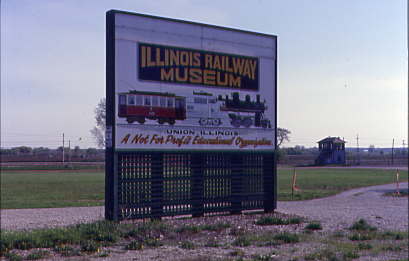
Since there was no one at the entrance, I decided to look around first and pay later.
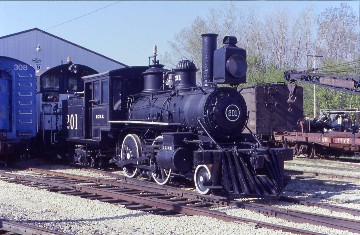
As the museum was celebrating Casey Jones Day, it made sense that my first photograph here was Illinois Central 2-4-0 201, ex. private ownership in Owatonna, Minnesota 1975-2002, exx. Vonachen's Junction in Peoria, Illinois 1965-1975, exxx. Illinois Central 201 1928-1965, exxxx. Illinois Central 1401 1900-1928, exxxxx. Illinois Central 201 1890-1900, exxxxxx. Illinois Central 221 1884-1890, nee Illinois Central 213 1880-1884 built by Rogers Locomotive Works in 1880.
This is the oldest steam locomotive at the museum and was acquired in 2002. Illinois Central employee Matthias Forney designed this type of locomotive specifically for use in suburban commuter service. While most steam engines were designed to be run forward over any distance, these "Forney" locomotives could operate in either direction with ease. This "double-ended" design made it possible to haul frequent passenger trains over short distances without having to physically turn the locomotive around at each end of the line.
The railroad used 201 and other locomotives on the line between downtown Chicago and the city's southern environs, one of the first suburban commuter operations in the country when it began in the 1860's. Commuter rail service expanded steadily during the late 1800's and early 1900's in many large cities as people moved to cheaper land in newly-created suburbs. By the early 1900's, the advantages of electric traction were becoming apparent. The IC commuter line was an obvious candidate for conversion from steam to electric power, as the smoke and pollution from the operation affected the parkland along the city's lakefront. The Lakefront Ordinance of 1919 required the IC to get rid of its steam-powered commuter trains and within ten years, locomotives such as 201 had been retired in favour of modern steel electric coaches.
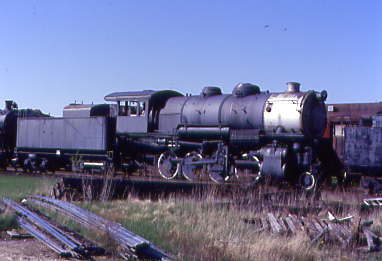
Chicago, Burlington and Quincy 2-8-2 4963 built by Baldwin in 1923, designed for use pulling heavy freight trains at low speed. Engines like this were nearly ubiquitous in mainline freight service in America in the years following World War I. This engine sat in a scrap yard for decades after retirement until acquired by IRM in 1990.
The 2-8-2 wheel arrangement was known as the Mikado, but the name's Japanese origins lost favor during World War II. For a brief period some people referred to 2-8-2 locomotives as "MacArthurs" in honour of the popular general. After the war ended, though, the Mikado name quickly returned.
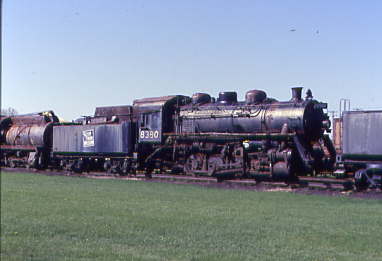
Illinois Ralway Museum 0-8-0 8380, ex. Northwestern Steel and Wire 80 1960-1980, nee Grand Trunk Western 8380 1929-1960, built by Baldwin in 1929. and designed for use moving the larger and heavier freight cars that were coming into use in the 1920's. It was also used on freight and even passenger trains on occasion. In the 1950's, it was retired and sold for scrapping but the scrap company instead used it, and several identical engines, for switching their facility. In this capacity it remained in use until 1980, one of the last steam engines in commercial use anywhere in North America.
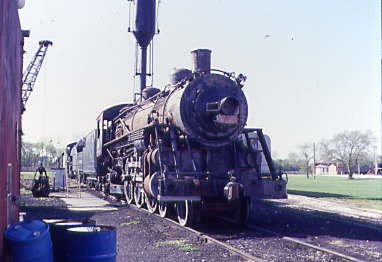
Illinois Railway Museum 2-8-8-2 2050, ex. Armco Steel 2050 1959-1975, nee Norfolk & Western 2050 1923-1959 built by American Locomotive Company in 1923. It is the only articulated steam engine preserved at IRM and one of only two 2-8-8-2 Mallet locomotives in existence. It is a United States Railroad Administration (USRA) standard design and saw use in low-speed drag freight service in the mountains of Virginia. It is a compound engine, which means that it uses steam twice: first in the rear (high pressure) set of cylinders and then in the front (low pressure) set of cylinders.
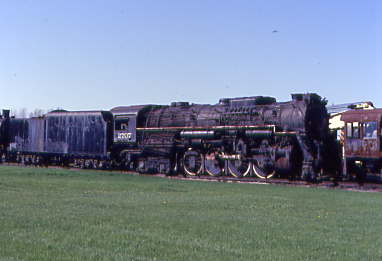
Chesapeake & Ohio 2-8-4 2707 built by American Locomotive Company in 1943. It is an example of a typical "Super Power" locomotive built towards the end of the steam locomotive era and features a large firebox and combustion chamber to provide more heat and, thus, more steam and more horsepower. Engines of this type were generally known as Berkshires but the C&O called them Kanawhas in honor of the river in West Virginia.
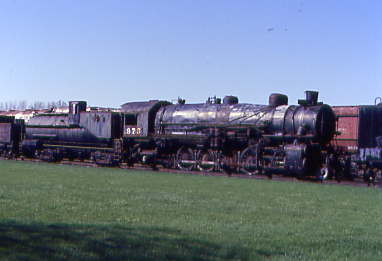
Illinois Railway Museum 2-10-2 975, ex. City of Beaumont, Texas 1954-1995, exx. Southern Pacific 975, nee Texas and New Orleans 975 built by American Locomotive Company in 1918, It is one of only five 2-10-2 engines preserved intact. This wheel arrangement was popular around World War I but was later supplanted by 2-8-4 and 2-10-4 engines that were faster and more powerful. While 2-10-2s were called "Santa Fe" types, the SP – a rival to the Santa Fe Railroad – called its 2-10-2s "Decks" despite the fact that "Decapod" typically refers to a 2-10-0.
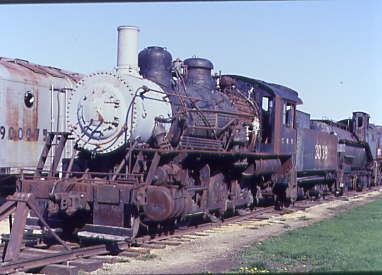
Illinois Railway Museum 2-6-0 3719, ex. Steamtown 3719 1963-1986, exx. Bevier and Southern 109 1946-1963, exxx. Illinois Central 3706 1943-1946, exxxx. Illinois Central 3719 1937-1943, nee Illinois Central 560 1900-1937, built by Brooks in 1900. This steam locomotive was designed to pull heavy freight trains at low speed and is among the largest 2-6-0s in preservation.
This is the only locomotive at IRM built by the Brooks Locomotive Works of Dunkirk, New York. Horatio G. Brooks founded the company in 1869 when he purchased a shop complex recently vacated by the New York & Erie Railroad and began building steam locomotives there. Brooks became a successful builder of locomotives. By 1900, it was the fifth-largest manufacturing plant in New York State. The company prided itself on building unusually large locomotives, with Illinois Central 3719 being a prime example of an engine larger and more powerful than most of its contemporaries. In 1901, Brooks and several other smaller steam locomotive builders merged to form the American Locomotive Company, or Alco. Afterward, the Brooks plant continued to produce steam engines under the Alco name until 1934. After that date it stopped locomotive production in favor of building pressure vessels and heat exchangers. The plant closed permanently in 1962.

Union Pacific steam-powered rotary snow plough 900075 built by Lima in 1949. It is effectively a giant snow blower, with its steam engine – housed entirely within the streamlined car body for easier maintenance in winter conditions, powering a large blade at the front that throws snow to the side of the tracks. It is not self-propelled and was designed to be pushed by a locomotive. Diesel-powered rotary snow ploughs are still employed by railroads but the last steam-powered rotary plow was retired in the 1970's.

Illinois Railway Museum DDA40X 6930, ex. Smoky Hill Railway and Historical Society 6930 1985-1991, nee Union Pacific 6930 1970-1985 built by Electro-Motive Division in 1970. It is one of 47 identical locomotives built exclusively for the UP and called "Centennials" because they were delivered starting around the 100th anniversary of the "Golden Spike" that completed the UP's transcontinental railroad. The locomotive features two separate diesel engines, or "prime movers" and eight powered axles.
It operated roughly 2,000,000 miles in service across the railroad's system, was retired in early 1981 and put into storage in Yermo, California. In March 1983, the Union Pacific was facing a traffic surge and placed 6930 and 24 other Centennials back into service. Locomotive 6930 ran for roughly two more years and was retired again in April 1985.

Illinois Railway Museum RS3 200, ex. Interlake Steel 19 1977-1984, exx. Eastman-Kodack 5 1973-1977, exxx. S.J. Groves & Sons 507 1970-1973, nee Minnesota Transfer 200 built by American Locomotive Company in 1951.
This engine helped build Interstate 280. In the early 1970's, highway contractor S.J. Groves & Sons laid railroad tracks along the planned route of Interstate 280 west of Newark, New Jersey to haul aggregate and fill for the huge construction project. This engine was bought used for this purpose and resold immediately once the highway was complete.
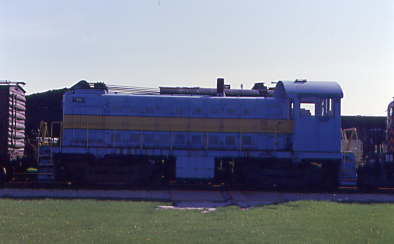
Nekoosa Paper S-1 14, nee South Omaha Terminal Railway 5, built by American Locomotive Company in 1947 and was designed to move freight cars around railroad yards at low speed.
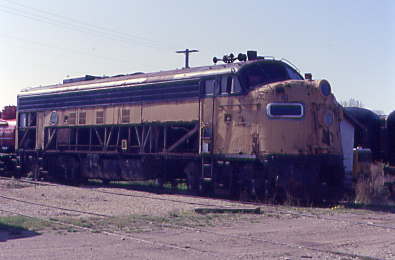
Chicago, Milwaukee, St. Paul and Pacific FP7A 104C, built by Electro-Motive Division in 1952 as an FP-series locomotive, a variant of the "F-unit" freight locomotive that was designed to pull either freight or passenger trains. This was done by making the engine longer so that it could accommodate a boiler, needed to provide steam heat to passenger cars. It is the only FP-series locomotive preserved at IRM.

Chicago, Milwaukee, St. Paul and Pacific F7B 96B, built by Electro-Motive Division in 1951. Known as a "booster", it was designed to supplement, or boost, the power of a manned locomotive or cab unit. After retirement, it was rebuilt as a generator car to power a rotary snow plough.
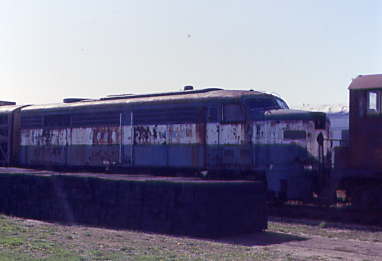
Illinois Railway Museum FA2 314, ex. Feather River Rail Society 314 1987-1996, exx. Long Island Rail Road 604 1971-1987, nee Louisville & Nashville 314 1956-1971, built by American Locomotive Company in 1956. While built for general freight train service on the Louisville and Nashville, it was later sold to the Long Island Railroad, which rebuilt it as a cab car for use on double-ended commuter trains. It is the museum's only cab unit built by Alco.
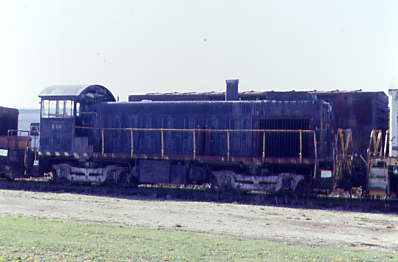
Dardanelle & Russellville SC 14 built by Electro-Motive Corporation in 1937 and is one of the oldest preserved locomotives built by Electro-Motive in LaGrange. It is also the only surviving SC type locomotive, so called because "S" referred to six hundred horsepower and "C" referred to a cast, rather than welded, frame. It is a diesel switching locomotive designed to move freight cars around railroad yards at low speed and is powered by the same type of engine that powered the Pioneer Zephyr.
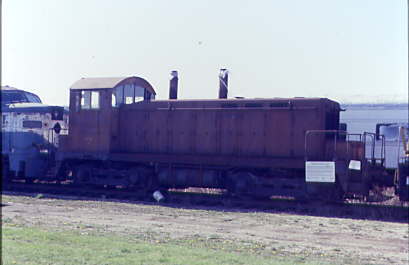
Armco Steel LS-1200 E110 built by Lima-Hamilton in 1951. It is one of only four Lima-Hamilton-built diesel locomotives in existence, built to switch cars for American Rolling Mill (Armco) at low speed. Its builder had been a famous steam locomotive manufacturer, but Lima failed to adapt well to the change from steam engines to diesels and went bankrupt in 1951. In fact, Armco E110 was the last locomotive ever built by Lima-Hamilton. It operated its entire career for Armco, at one point having its cab replaced by the cab from a similar locomotive, Baltimore & Ohio 9397.
Lima-Hamilton was the result of a 1947 merger between the Lima Locomotive Works of Lima, Ohio and the General Machinery Corporation of Hamilton, Ohio. For decades, it concentrated on building low-speed geared freight locomotives known as Shays. Starting in the 1920's, it inaugurated the "Super Power" concept of high-tractive effort, high-speed steam locomotives. The company met with great success building these, but once World War II ended and railroads stopped ordering steam engines in favor of diesels, Lima was slow to adapt. Its 1947 merger gave Lima the ability to use diesel engine technology already developed by General Machinery Corporation, but it did not sell its first diesel locomotive until 1949. Its engines also competed poorly with other, more established diesel manufacturers. Lima-Hamilton merged with the Baldwin Locomotive Works in 1951 to form Baldwin-Lima-Hamilton (BLH). BLH discontinued the line of former Lima-Hamilton diesel locomotives in favor of more popular Baldwin diesel designs.
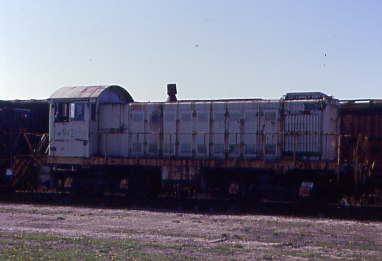
Illinois Railway Museum S1 203, ex. Midwest Steel 203, nee Delray Connecting Railroad 66 built by American Locomotive Company in 1947.
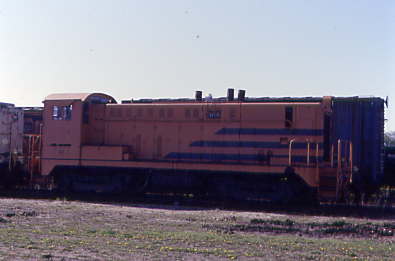
Wyandotte Terminal Railroad VO660 103 built by Baldwin in 1945 and designed to move freight cars around railroad yards at low speed. It operated its entire career on the Wyandotte Terminal, a switching railroad located in a southern suburb of Detroit.

Metra F7A 308, ex. RTA 414, exx. Chicago and North Western 414, nee Chicago and North Western 4083C, built by Electro-Motive Division in 1949. After being used in general freight service, it was rebuilt in 1961 for use pulling bi-level commuter trains in the Chicago area and renumbered C&NW 414. It ended its career hauling ballast trains for Metra.
I then started my tour of the car barns beginning with Barn 8.

Here is Milwaukee Road 4-8-4 265, sister to Milwaukee Road 261, as well as Pennsylvania Railroad GG-1 4927.
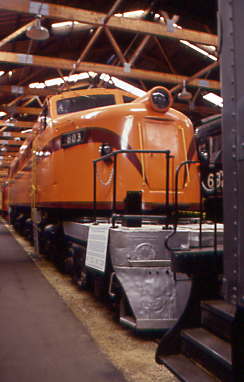
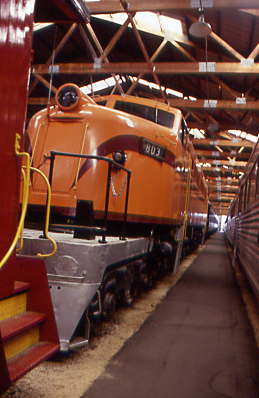
Chicago South Shore & South Bend electric locomotive 803 built by General Electric in 1949. It is the largest operating electric locomotive in North America and was built for export to Russia but due to the advent of the Cold War, the sale was cancelled and the locomotive was instead sold to the South Shore for fast freight service. It was retired in 1981, by which time it and sister locomotive 802 were the last electric locomotives in mainline freight service on a United States common carrier railroad. It came to IRM that year in operating condition.
A dozen electric locomotives identical to 803 were sold to the Milwaukee Road and operated in the Pacific Northwest. They were nicknamed "Little Joes" because they had been built for the Soviet Union, led by Josef Stalin.
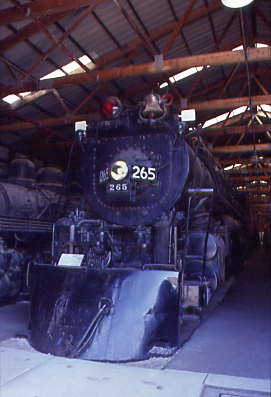
Illinois Railway Museum 4-8-4 265, ex. City of Milwaukee 265 1957-1975, nee Chicago, Milwaukee, St. Paul and Pacific 265 built by American Locomotive Company in 1944. It is a heavy mixed-traffic locomotive designed for high-speed passenger and express freight use and was used for only a decade or so before it was retired and replaced with diesels. It was on display in a park in Milwaukee, where it was nicknamed "Old Smokey", for some two decades before coming to IRM.
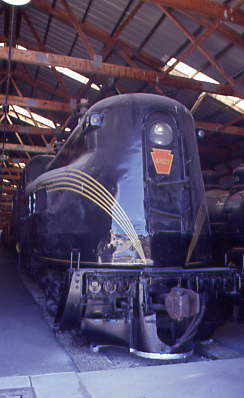
Illinois Railway Museum GG1 4927, ex. Amtrak 4939 1976-1981, exx. Penn Central 4927 1968-1976, nee Pennsylvania Railroad 4927 1942-1968 built by General Electric in 1942. The PRR built more than 130 of these locomotives and they pulled both passenger and freight trains between Washington, DC and New York City for nearly 50 years.
The GG-1 is the museum's only train to have been featured on a postage stamp. The US Post Office debuted a series of locomotive stamps in 1999 and PRR 4927 was repainted specially for the occasion.
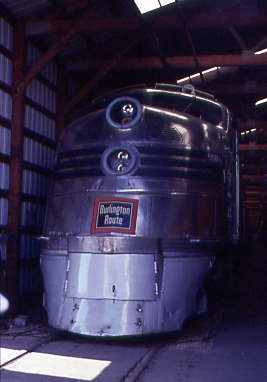
Illinois Railway Museum E5A 9911A, ex. Electro-Motive Division 9911A 1968-1969, exx. Colorado and Southern 9952A 1955-1968, nee Chicago Burlington & Quincy 9911A "Silver Pilot" 1940-1955 built by Electro-Motive Corportion in 1940. It was built to haul the railroad's Zephyr passenger trains and was designed for a top speed of 115mph. It was one of only a few passenger diesel locomotives ever clad entirely in stainless steel so that it could match its train. It was acquired in 1968 to pull the Nebraska Zephyr train set at the museum.
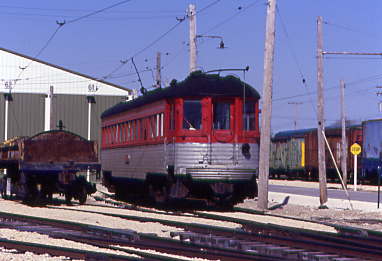
Illinois Railway Museum interurban coach 757, ex. Wisconsin Electric Railway Historical Society 757 1967-1988, exx. private owner 1963-1967, nee Chicago, North Shore and Milwaukee 757 1930-1963, built by Standard Steel Car Company in 1930. It was designed for use between Chicago and Milwaukee then went through the North Shore's "Silverliner" modernization program in the 1950's which included upgraded seating, interior lighting and a faux-stainless-steel paint scheme. This car was unique in the North Shore fleet because it lacked the usual wooden slats, nicknamed "lobster traps", covering the ends of its roof.
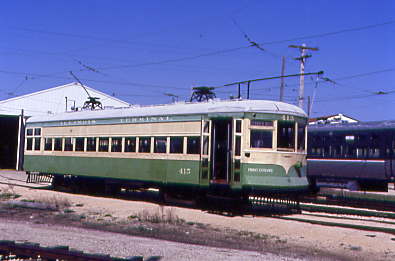
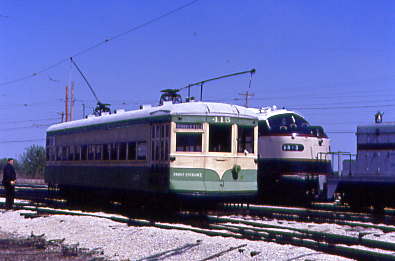
Illinois Railway Museum interurban car 415, ex. Illinois Terminal 415 1934-1956, exx. Chicago and Illinois Valley 64 1929-1934, nee Illinois Traction System 64 built by St. Louis Car Company in 1924. It is a lightweight one-man interurban car that in its later years was used in suburban service between St. Louis, Missouri and Granite City, Illinois. When new, it was designed for long-distance service along the Illinois Valley between Chicago and Princeton. In the mid-1930's it was rebuilt for short-distance suburban service and in 1966, became the first car to operate at the Illinois Railway Museum.
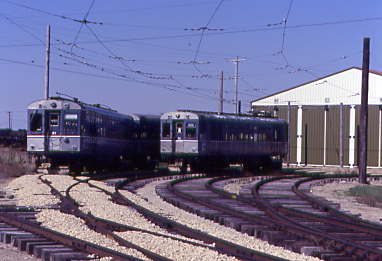
CTA cars.
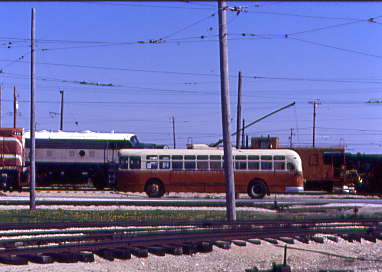
Illinois Railway Museum trolley bus 441, ex. Milwaukee and Suburban Transport 441 1952-1965, nee Milwaukee Electric Railway and Transport Company 441 built by Marmon-Herrington in 1948.
The Milwaukee Electric Railway and Light Company served Milwaukee residents' transit needs well, operating electric interurban lines to outlying towns and streetcars and motor buses in the city. Starting in 1936, they began replacing some streetcar routes with trolley buses, which they called "trackless trolleys" as in many Northeastern cities. Conversion of streetcar routes to trackless trolley accelerated after World War II, and ten lines eventually made up the system.
Marmon-Herrington, based in Indianapolis, entered the trolley bus market later than its rail-oriented competitors. It built its first vehicle in 1946, but its superior design quickly made it the largest seller. Marmon built only one design of trolley bus, varying only in number of seats and width of doors. They built bus 441, a 44-seat model, as part of an order for 26 vehicles. This was Milwaukee's final order of trolley buses, although they received 90 used units from Indianapolis when that system closed in 1957.
Trackless 441 was originally bought to convert the important Third St. line from streetcar to trolley bus service. It was then assigned to the Oakland car station on Milwaukee's northeast side for most of its life. Its final years were out of Kinnickinnic station at Kinnickinnic and Mitchell, on the near south side. Ownership of the Railway changed hands in 1952. Previously a subsidiary of Wisconsin Electric Power, it became privately held and took the name Milwaukee & Suburban Transport. The new owners found that without subsidized electric power, declining ridership and inexpensive diesel fuel made conversion to diesel buses an economic necessity. Trackless 441 was retired on June 20, 1965, when the system was abandoned and was donated to IRM, while most of its sister buses were sold to Mexico City for further use. It is complete, restored, and operational.
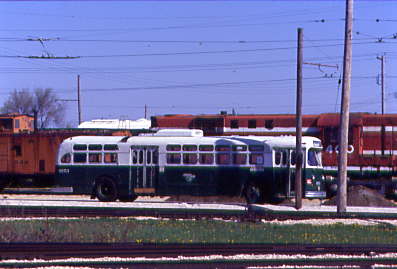
Illinois Railway Museum trolley bus 192, ex. Chicago Transit Authority 9192 1952-1959, exx. Chicago Transit Authority 192 1945-1952, nee Chicago Surface Lines 192 1937-1947 built by J.G. Brill in 1937.
Starting in 1930, the Chicago Surface Lines began service on seven routes on the Northwest Side with trolley buses. At the time, the area was not heavily populated by Chicago standards, so the 114 vehicles purchased during 1930-1931 were a fairly small fleet compared to the more than 3,000 streetcars that CSL operated. The trolley bus was a new enough idea, however, that they represented by far the largest fleet in the country. After the leanest years of the Great Depression had passed, CSL began purchasing more trolley buses to expand service.
In 1937, they bought from Philadelphia's J. G. Brill Co., the country's largest streetcar builder, 17 streamlined model T40S trolley buses. These were significantly more modern vehicles than their predecessors in almost every way, from passenger comfort to ease of operation. They seated 40 passengers. Bus 192 operated on the 76-Diversey route for almost its entire service life. It was retired in 1958, purchased by Glenn Andersen, and stored with the rest of our Museum's rail equipment collection at our original site in North Chicago. When IRM moved to Union in 1964, bus 192 was included, and Glenn formally donated it to the Museum in 1966 and became our first Trolley Bus Department Curator.
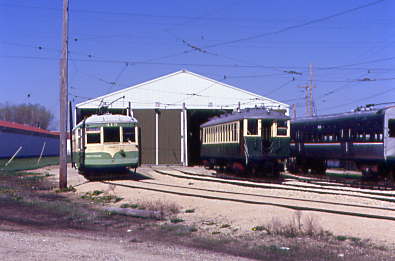
Illinois Terminal 415 and Chicago Transit Authority 4290.
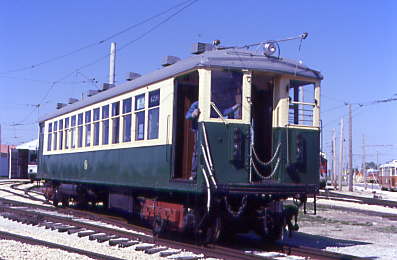
Illinois Railway Museum "L" car 4290, ex. Chicago Transit Authority 4290 1947-1978, exx. Chicago Rapid Transit 4290 1924-1947, nee Chicago Elevated Railway 4290 1922-1924, built by Cincinnati Car Company in 1922. These cars were similar to the earlier "Baldies" but had wood-and-canvas roofs with trolley poles and cloth seats to which they owed the nickname "Plushies". Car 4290 ran in Chicago for more than 55 years and in later years, on the Evanston line (now the Purple Line).
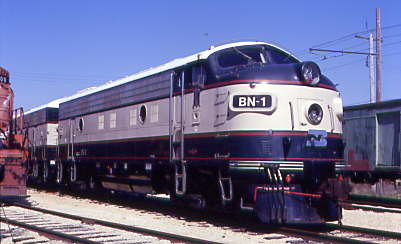
Illinois Railway Museum F9A BN1, ex. BNSF BN1 1995-1997, exx. Burlington Northern BN1 1990-1995, exxx. Burlington Northern 972567 1981-1990, exxxx. Burlington Northern 766 1973-1981, exxxxx. Burlington Northern 9800 1970-1973, nee Northern Pacific 6700A 1954-1970, built by Electro-Motive Division in 1954.
It was built as a mixed-traffic engine for the Northern Pacific Railroad, which used it to pull both passenger and freight trains then was switched to pure freight duty in the early 1970's and was later rebuilt as a power unit for a rotary snow plough. In 1990, it was again rebuilt with modern equipment for the purpose of pulling the BN's executive train of passenger cars.
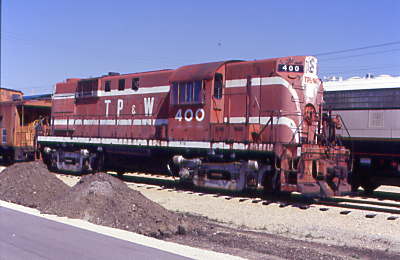
Toledo Peoria & Western RS11 400 built by American Locomotive Company in 1958 and designed for general freight train service.
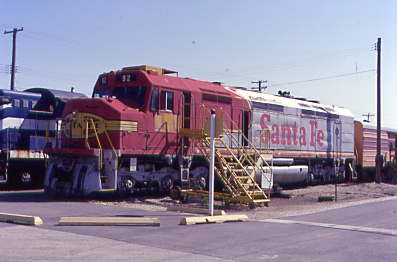
Illinois Railay Museum FP45 92, ex. Santa Fe 92 exx. Santa Fe 5992 exxx. Santa Fe 101:6, nee Santa Fe 102, built by Electro-Motive Division in 1957. It is one of the most modern passenger diesels at IRM and was built to power fast passenger trains for the Santa Fe but, since passenger trains were quickly dying out in the 1960's, it was built so that it could also be used to pull freight trains. After Amtrak took over intercity passenger service in 1971, this engine was rebuilt to haul express freight trains between Chicago and Los Angeles. It was one of two engines repainted in traditional red and silver to debut the "Super Fleet" program in 1991.

Columbus & Greenville AS416 606 built by Baldwin in 1950 and designed as a road switcher for general freight train service. It is one of only two examples of AS416 locomotives in preservation and a rare example of a diesel built by Baldwin, a renowned steam engine builder that built its last locomotive in 1956.
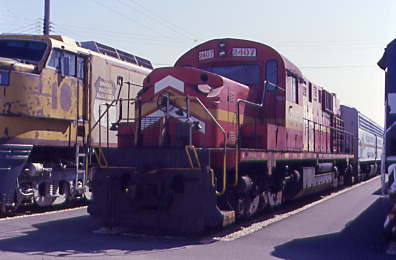
Illinois Railway Museum RSD15 2407, ex. Green Bay & Western 2407 1993-1996, exx. Fox River Valley Railroad 2402 1989-1993, exxx. Lake Superior and Ishpeming 2402 1975-1989, exxxx. Santa Fe 9841 1969-1975, nee Santa Fe 941, built by America Locomotive Company in 1960.
Designed as a road switcher for general freight train service, it pulled freight trains between Chicago and Los Angeles for the first parts of its career then when owned by Lake Superior & Ishpeming, it hauled coal trains in Michigan's Upper Peninsula.
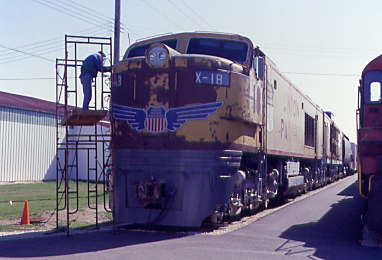
Union Pacific gas turbine (8500 GTEL) X-18 built by General Electric in 1960, one of the most powerful locomotives built in America. Rated at 10,000 hp, it consists of the cab unit; the main power unit containing a turbine engine, similar to a jet engine, numbered 18B; and a tender to carry fuel for the turbine. The railroad designed these locomotives specifically to pull freight trains between Omaha, Nebraska and Ogden, Utah and 18 is one of only two in preservation. Their poor fuel economy and high maintenance costs of the turbine led to their retirement in the late 1960's.
It was the 1930's when railroads began looking at turbine-driven locomotives as a way to increase fuel economy. Turbines used at power plants were very efficient, but finding a way to mount a turbine on a locomotive proved problematic. General Electric built a turbine locomotive for the Union Pacific Railroad in 1939 but its complexity made it unreliable and it was deemed a failure. After World War II, the UP revisited the idea. It asked General Electric to build on its experience designing gas turbine airplane engines and construct a gas-powered turbine locomotive. A prototype built in 1948 was judged successful, so three orders of gas turbines were built between 1952 and 1961. These culminated in the three-unit, 8,500 hp locomotives like UP 18. The turbines were essentially jet engines on rails, and when in operation they sounded like jet airliners. They used fuel at a prodigious rate, though the poor grade of oil that they burned helped offset the cost somewhat. They also used nearly as much fuel at idle as at full throttle, meaning that the railroad had to keep them in constant use while fired up.
Over time, as oil prices climbed and reliability problems increased, the turbines fell out of favor with the UP. The railroad ended up retiring them all by 1970, and sold nearly all for scrap. UP 18 is one of only two turbine locomotives from the Union Pacific still in existence. It retains its turbine engine but was stripped of many other components before acquisition by the museum.
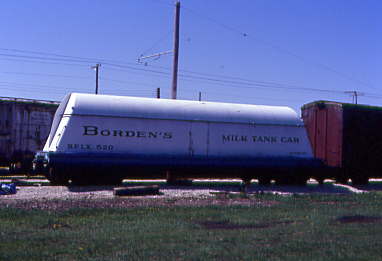
Bordens Milk steel milk car 520 built by Merchants Despatch Transportation Company in 1935. This "butter dish" milk car, so called because of its unusual Art Deco-inspired shape, was was designed for hauling fresh milk inside large glass-lined tanks. At the end of its career, after the transportation of milk had switched to over-the-road trucking, this car was used to transport glue products.

Commonwealth Edison SW1 15 built by Electro-Motive Division in 1950 and was designed to move freight cars around railroad yards at low speed. In its later years, it was used at the nuclear power plant in Byron, Illinois.
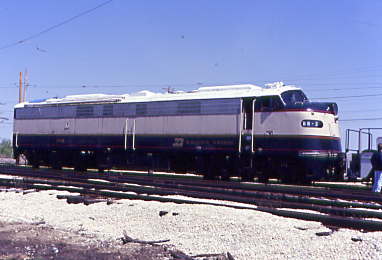
Illinois Railway Museum E9A BN3, ex. BNSF BN3 1995-1997, exx. Burlington Northern BN3 1990-1995, exxx. Burlington Northern 9919 1973-1990, exxxx. Burlington Northern 9989 1970-1973, nee Chicago, Burlington and Quincy 9989A 1965-1970 built by Electro-Motive Division in 1956.
It was built to haul long-distance passenger trains like the Denver Zephyr then was later rebuilt to pull commuter trains between Chicago and Aurora. In 1990, it was assigned to pull the BN executive train of passenger cars.
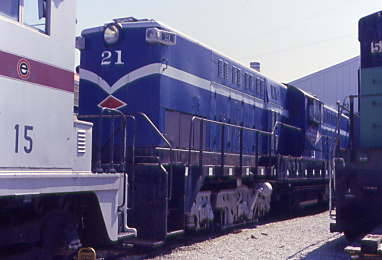
Minneapolis Northfield & Southern Railway DT6-6-2000 21 built by Baldwin in 1948. It is the only preserved Baldwin center-cab freight locomotive and was designed as a road switcher for general freight train service and has two diesel engines, one at each end of the locomotive.
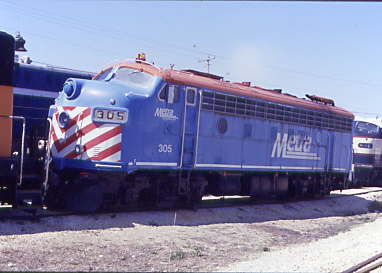
Metra F7A 305, ex. RTA 305, exx. Chicago and North Western 305, nee Chicago and North Western 4082C built by Electro-Motive Division in 1949. It was built as freight locomotive and used in general freight service then in 1961, was rebuilt for use pulling bi-level commuter trains in the Chicago area.
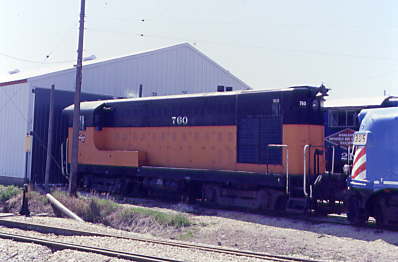
Illinois Railway Museum H10-44 760, ex. Chicago, Milwaukee, St. Paul & Pacific 760 1959-1981, nee Chicago, Milwaukee, St. Paul and Pacific 1802 1944-1959 built by Fairbanks-Morse in 1944. This was the first diesel locomotive built by Fairbanks-Morse and was designed to move freight cars around railroad yards at low speed.
The above is just a small sampling of the magnitude of this railway museum's collection. The volunteers who run this make everything happen here and they do an excellent job.
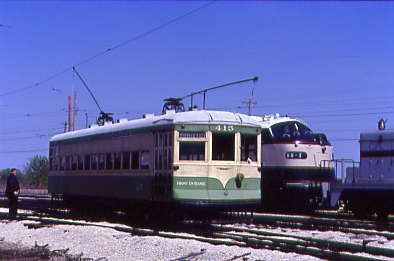
It was time for a train ride and I started with the loop that goes around the museum's grounds, aboard Illinois Traction 415. This trip gives the rider an excellent view of most of the outside displays.
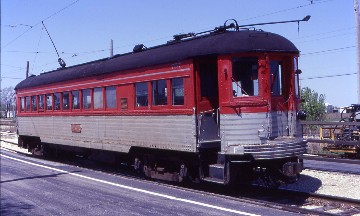
Once the trip around the loop was complete, it was then time for the mainline trip and I boarded North Shore 757 and we proceeded into the Illinois countryside and I felt as though I was riding a real interurban train.
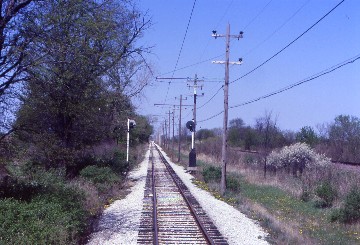
The view on the return trip, when we passed the depot and ran to the end of the line at Union before going back.
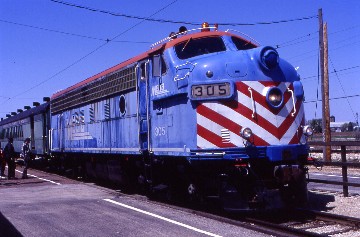
Metra F7A 305, which was going to pull a train later this afternoon. Unfortunately, my other photographs did not turn out and I left this fantastic museum as I said goodbye to the friendly train crews. I drove east until reaching Illinois 47, onto which I turned left and that became Wisconsin 120 and took me though beautiful Lake Geneva then onto East Troy, my next stop.
East Troy Electric Railway Museum 5/3/2003The East Troy Electric Railroad is an interurban heritage railroad owned and operated by the East Troy Railroad Museum. Passenger excursions run on a 7-mile stretch of track from East Troy, Wisconsin to Mukwonago, Wisconsin. The line dates back to 1907, when it was a part of The Milwaukee Electric Railway and Light Company line from East Troy to Milwaukee.
The East Troy-Mukwonago segment was purchased by the Village of East Troy in 1939, when the remainder of the line to Hales Corners was abandoned. Under terms of the purchase, it was operated by TMER&L crews for ten years. In 1949, TMER&L declined to renew the agreement for another ten years and the village hired its own crew and operated the railroad from 1950 until 1985. This is when the railroad became the Municipality of East Troy Wisconsin Railroad and adopted the reporting symbol METW. In 1985 the village approached the Wisconsin Trolley Museum and asked them to take over the operation of the railroad. They agreed to do so, and moved their collection of trolleys to East Troy.
Museum operations began over the line as early as 1967 when The Wisconsin Electric Railway Historical Society relocated its collection of electric railway equipment from North Freedom, Wisconsin to East Troy. TWERHS operated over the line using a trackage rights agreement with the village until 1984, when the trackage rights agreement ended and the Wisconsin Trolley Museum began to operate the line as the East Troy Electric Railroad. The Friends of East Troy Railroad Museum, Inc. purchased the rail line from the village and also purchased the trolley collection of Paul Averdung between 1995 and 2000 in stages.
The East Troy Railroad Museum operates a museum and just over 7 miles of track offering rides on a weekly basis during the spring through fall season. The original substation building in East Troy, Wisconsin is used as a ticket office and museum, and visitors can purchase rides to the Elegant Farmer store at Phantom Woods, and to Indianhead Park in Mukwonago. A collection of approximately 30 pieces of electric railway equipment is kept in storage barns in downtown East Troy and at Phantom Woods. The museum is a 501(c)(3) non-profit educational corporation run by volunteers. The substation, located at 2002 Church Street in East Troy, is on the National Register of Historic Places.
The railway itself is a standard gauge common carrier railroad that operates in interchange with Canadian National Railway (formerly a connection to Wisconsin Central Ltd.). This gives the East Troy electric railroad the ability to pick up and deliver freight (including fertilizer for the Farmers Co-op, sand for the local Ready-Mix, and lumber and steel tubing) to the village of East Troy. However, the railroad has not been used to carry freight for at least ten years. Much of the track is original and the rail bed was refurbished during the mid-1990s. The line is completely electric, utilizing a 600 V direct current system. Power is supplied to trolleys and interurban railroad cars through overhead wires. The original 500 kW rotary converter motor-generator is no longer used and is on display at the museum.
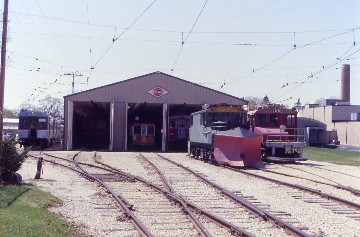
I arrived then walked over to the depot where I introduced myself and was told to enjoy my visit to the car barn. I walked down the right-of-way and outside found Milwaukee Electric Railway & Light Company 50-ton steeplecab locomotive L9 built by the company in 1944, and Milwaukee Electric Railway & Light Company 50-ton steeplecab locomotive L-8 built by the company in 1935.
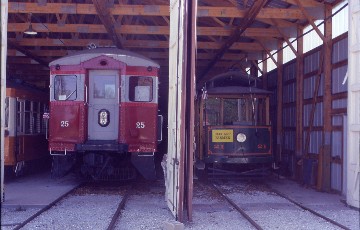
On the left is Chicago, South Shore and South Bend Diner 25 "Ravenswood" built by the Pullman Company in 1927, while on the right is East Troy Electric Railroad single truck open car 21 built by the railroad in 1975 as a reproduction of an 1890's style open streetcar.
I had an enjoyable visit before driving to the Sleep Inn in Mukwonago for a restful evening.
5/4/2003 Sleeping in is a highly unusual event for me and after a continental breakfast, I drove back to Milwaukee, taking Interstate 43 to Interstate 834, to Interstate 94 to Miller Park Way and passed the ballpark, choosing to fill the rental car with petrol in preparation for returning it later this afternoon. I was able to park for free as I arrived so early, then walked to Miller Park with the roof closed.
Miller Park New York Mets versus the Milwaukee Brewers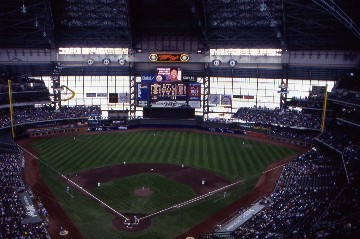
I went up to fourth deck and found my seat in the no-alcohol Family Section 518. Miller Park is one of the major league parks with a retractable roof and since there was a front on its way,the roof would stay closed for the game. I learned from a park employee that it takes between ten and eleven minutes to open or close. There is an arch of glass windows above the first and third base stands that allow plenty of natural light, but they are augmented by banks of lights. Behind the outfield is also glass. The field is, of course, real grass and this was an amazing ball park. I watched both teams take batting practice then saw the ground crews prepare the field. Bernie Brewer, the mascot, did his pre-game antics from Bernie's Dugout, including his slide to fireworks to waving the Brewers flag.
Now to the game. At the bottom of the first, Richie Sexson hit a solo blast off the Piggly Wiggly sign above center field. There was a marriage proposal in the form of "Becky, will you marry me?" in the bottom of the third with "Yes" as the answer. Also that inning, the Brewers added another run after Clayton Royce singled, sacrificed by the pitcher Matt King to second, then Alex Sanchez hit a triple to score him. In the top of the fifth, the Mets loaded the bases and Cliff Floyd hit a grand slam to deep center. The Brewers made it close when Alex Sanchez stole third and went home on a Mike Piazza throwing error, bringing the score to 4-3 Mets. In the top of the eighth, the Brewers walked in a run to make the final score 5-3 Mets, before 18,571 fans.
I returned the rental car just before the Empire Builder arrived and walked over to the Ramada Inn, checked in and received a room on the sixth floor then visited the gift shop for some postcards.
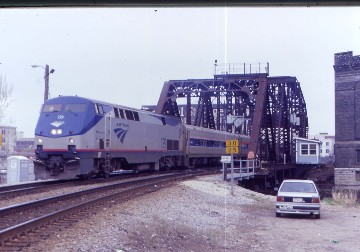
Hiawatha Service 377 arriving from Chicago as seen from the the grade crossing at the east end of the depot. Upon my return to the hotel, I mailed a postcard before having a roast beef dinner in the hotel's restaurant then returned to my room to relax for the rest of the evening.
| RETURN TO THE MAIN PAGE |